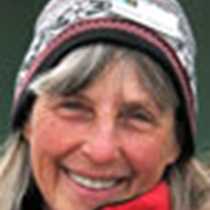William’s Cove & Tracy Arm
Dense fog merged into quicksilver water with no perceptible transition. Occasionally we glimpsed a chunk of floating glacial ice resting motionless on the glassy surface. The National Geographic Sea Lion worked its way into William’s Cove, and the anchor dropped in preparation for our morning’s activities. The shoreline of this quiet bay offered a great introduction to the temperate rainforest of Southeast Alaska. A lush understory of ferns and blueberry bushes covered the forest floor beneath towering Sitka spruces and western hemlock trees. Rivulets of fresh water supported patches of skunk cabbage with immense leaves that can reach 1.5 meters in length. In addition to wandering the forest paths and the intertidal flats, kayaking was an option. The colorful plastic boats provided a wonderful way to explore from a different perspective. Waterfalls and several beautiful pieces of ice attracted boaters for closer views.
Throughout the afternoon the ship carried us through a spectacular fiord that is part of the Tracy Arm/Fords Terror Wilderness Area within Tongass National Forest. Walls of rock carved by previous glacial action rose abruptly from sea level. There were textbook examples of geologic features such as U-shaped valleys, glacial scouring, domes and nunataks. Snowmelt and rainwater tumbled down the steep walls in waterfalls of every kind imaginable. Wispy veils, pounding cascades and one special one, Hole-in-the-Wall, graced the already stunning scenery. When we approached the end of the fiord, jagged pinnacles of the South Sawyer Glacier suddenly appeared. Floating ice called bergie bits and growlers gently rubbed the hull as the officers carefully maneuvered towards the deep blue face of South Sawyer. Harbor seals studied our progress from their resting spots on the drifting ice. To retain warmth, they often hold heads and tails in the air. A thick blubber layer protects them from too much heat loss. We waited, hoping that the precarious ice pillars would crumble or crash into the sediment-laden water below. Good fortune was with us, for several calving events rewarded our patience. The ship turned and made way for the nearby Sawyer Glacier, another spectacular tongue of ice fed by the Stikine Icefield. Eventually it was time to leave this raw landscape of ice and rock and follow our route back towards Stephens Passage. The welcome warmth of the ship lured us into the lounge for appetizers and cocktails. It was a fitting end to our first full day of exploration together in Southeast Alaska.
Dense fog merged into quicksilver water with no perceptible transition. Occasionally we glimpsed a chunk of floating glacial ice resting motionless on the glassy surface. The National Geographic Sea Lion worked its way into William’s Cove, and the anchor dropped in preparation for our morning’s activities. The shoreline of this quiet bay offered a great introduction to the temperate rainforest of Southeast Alaska. A lush understory of ferns and blueberry bushes covered the forest floor beneath towering Sitka spruces and western hemlock trees. Rivulets of fresh water supported patches of skunk cabbage with immense leaves that can reach 1.5 meters in length. In addition to wandering the forest paths and the intertidal flats, kayaking was an option. The colorful plastic boats provided a wonderful way to explore from a different perspective. Waterfalls and several beautiful pieces of ice attracted boaters for closer views.
Throughout the afternoon the ship carried us through a spectacular fiord that is part of the Tracy Arm/Fords Terror Wilderness Area within Tongass National Forest. Walls of rock carved by previous glacial action rose abruptly from sea level. There were textbook examples of geologic features such as U-shaped valleys, glacial scouring, domes and nunataks. Snowmelt and rainwater tumbled down the steep walls in waterfalls of every kind imaginable. Wispy veils, pounding cascades and one special one, Hole-in-the-Wall, graced the already stunning scenery. When we approached the end of the fiord, jagged pinnacles of the South Sawyer Glacier suddenly appeared. Floating ice called bergie bits and growlers gently rubbed the hull as the officers carefully maneuvered towards the deep blue face of South Sawyer. Harbor seals studied our progress from their resting spots on the drifting ice. To retain warmth, they often hold heads and tails in the air. A thick blubber layer protects them from too much heat loss. We waited, hoping that the precarious ice pillars would crumble or crash into the sediment-laden water below. Good fortune was with us, for several calving events rewarded our patience. The ship turned and made way for the nearby Sawyer Glacier, another spectacular tongue of ice fed by the Stikine Icefield. Eventually it was time to leave this raw landscape of ice and rock and follow our route back towards Stephens Passage. The welcome warmth of the ship lured us into the lounge for appetizers and cocktails. It was a fitting end to our first full day of exploration together in Southeast Alaska.



